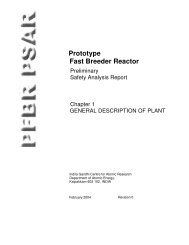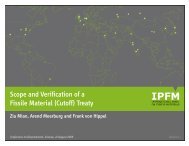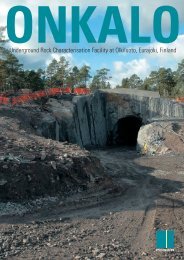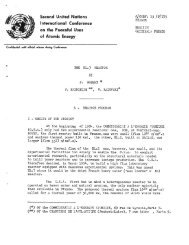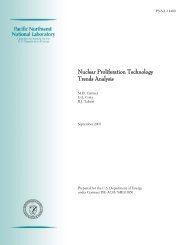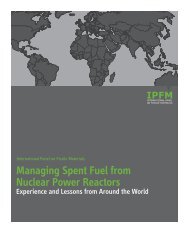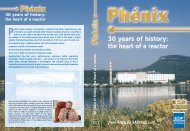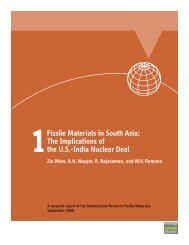Global Fissile Material Report 2009: A Path to Nuclear Disarmament
Global Fissile Material Report 2009: A Path to Nuclear Disarmament
Global Fissile Material Report 2009: A Path to Nuclear Disarmament
You also want an ePaper? Increase the reach of your titles
YUMPU automatically turns print PDFs into web optimized ePapers that Google loves.
1400 kg that were used annually in the early 1980s. We continue <strong>to</strong> assign about 70<strong>to</strong>ns of HEU <strong>to</strong> the civilian research reac<strong>to</strong>r fuel cycle, which includes about 10 <strong>to</strong>ns(6.7 <strong>to</strong>ns of 235 U in HEU) that are under IAEA safeguards in NPT non-weapon states andat least 1.3 <strong>to</strong>ns under voluntary offer agreements in weapon states. 42Civilian uranium enrichment plants. There are currently civilian uranium enrichmentplants operating, under construction or planned in ten states. These enrichmentplants are intended <strong>to</strong> produce LEU for nuclear power reac<strong>to</strong>r fuel, but could in principlequickly be turned <strong>to</strong> producing HEU for weapons. Appendix 1A lists all enrichmentplants and whether they are under or have been offered for International A<strong>to</strong>micEnergy Agency (IAEA) safeguards. About half are under safeguards.The two new enrichment plants <strong>to</strong> begin initial testing and operation in <strong>2009</strong> wereAreva’s George Besse II centrifuge enrichment plant, located at the Tricastin Site inFrance, and Urenco’s Eunice plant in the United States. 43 Two additional new largescalecentrifuge enrichment plants are at various stages of development in the UnitedStates and could be completed over the next decade. 44 Also, in July <strong>2009</strong>, <strong>Global</strong> LaserEnrichment (GLE) filed a U.S. license application for a large laser-enrichment plant <strong>to</strong>begin commercial operation in 2012. 45 There were significant capacity increases at theUrenco enrichment plants in Germany, the Netherlands, and the United Kingdom,which <strong>to</strong>gether delivered an additional 1300 tSWU in 2008 compared <strong>to</strong> 2007. 46 Russiaalso has been increasing the capacity at its domestic enrichment plants, 47 as well as atthe centrifuge plant it supplied <strong>to</strong> China. In March <strong>2009</strong>, Russia announced plans withToshiba <strong>to</strong> build an enrichment plant in Japan. 48Separated Plu<strong>to</strong>niumSince 1944, more than 60 dedicated reac<strong>to</strong>rs have been used by the nine weapon states<strong>to</strong> produce plu<strong>to</strong>nium for weapons purposes (IPFM estimate). As of <strong>2009</strong>, nearly allof these reac<strong>to</strong>rs have been closed-down or dismantled and only India, Pakistan andperhaps Israel continue <strong>to</strong> produce plu<strong>to</strong>nium for weapons. In addition, six countriesreprocess their commercial spent fuel <strong>to</strong>day: France, India, Japan, and Russia are deeplycommitted <strong>to</strong> reprocessing; China is testing a pilot reprocessing plant and is contemplatingcommercial reprocessing; and the United Kingdom is on the verge of abandoningreprocessing.The global s<strong>to</strong>ckpile of separated plu<strong>to</strong>nium is about 500 <strong>to</strong>ns. It is divided almostequally between civilian and military s<strong>to</strong>cks—the latter including material declaredexcess but not yet disposed (Figure 1.3). Separated plu<strong>to</strong>nium exists mostly in nuclearweaponstates, but Japan and Germany also have significant s<strong>to</strong>cks. The buildup ofcivilian s<strong>to</strong>ckpiles has slowed down with a dozen countries not renewing their contracts<strong>to</strong> have their spent fuel reprocessed by France, Russia and/or the UK and boththe United Kingdom and Japan having <strong>to</strong> shut down their reprocessing plants becauseof equipment problems.Weapons plu<strong>to</strong>nium. Russia and the United States possess by far the largest s<strong>to</strong>cks ofmilitary plu<strong>to</strong>nium: 120–170 and 92 <strong>to</strong>ns, respectively. Russia has declared 34 <strong>to</strong>nsof its weapon-grade plu<strong>to</strong>nium excess for military purposes. 49 The United States hasdeclared excess 54 <strong>to</strong>ns of separated government-owned plu<strong>to</strong>nium, which includes9 additional <strong>to</strong>ns of weapon-grade plu<strong>to</strong>nium added in September 2007. 50 In 1998,the United Kingdom declared excess 0.3 <strong>to</strong>ns of its 3.5-<strong>to</strong>n s<strong>to</strong>ckpile of weapon-gradeplu<strong>to</strong>nium. 51<strong>Global</strong> <strong>Fissile</strong> <strong>Material</strong> <strong>Report</strong> <strong>2009</strong> 15



